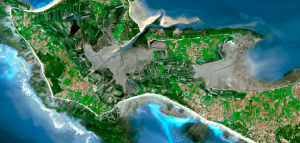A footbridge or pedestrian bridge is a bridge designed for pedestrians and in some cases cyclists, animal traffic and horse riders, rather than vehicular traffic. Footbridges complement the landscape and can be used decoratively to visually link two distinct areas or to signal a transaction. In many developed countries, footbridges are both functional and can be beautiful works of art and sculpture.
1. BP Pedestrian Bridge, Illinois, USA
 link
linkThe BP Pedestrian Bridge, or simply BP Bridge, is a girder footbridge in the Loop community area of Chicago, Illinois, United States. This pedestrian bridge serves as a noise barrier for traffic sounds from Columbus Drive. It is a connecting link between Millennium Park and destinations to the east, such as the nearby lakefront, other parts of Grant Park and a parking garage.
 link
linkBP Bridge uses a concealed box girder design with a concrete base, and its deck is covered by hardwood floor boards. It is designed without handrails, using stainless steel parapets instead. The total length is 935 feet (285 m), with a five percent slope on its inclined surfaces that makes it barrier free and accessible. Although the bridge is closed in winter because ice cannot be safely removed from its wooden walkway, it has received favorable reviews for its design and aesthetics. [
link,
map]
2. Capilano Suspension Bridge, Canada
 link
linkThe Capilano Suspension Bridge is Vancouver’s oldest tourist attraction, having been built in 1889. The current bridge is 450 feet (137m) across and 230 feet (70m) above the river. The Capilano Suspension Bridge and Park draws over 800,000 visitors a year. It offers splendid views of the river below and old growth forest. Experiencing the thrill of Vancouver's largest suspension bridge is a must for any local or visitor.
 link
linkThe bridge was originally built in 1889 by George Grant Mackay, a Scottish civil engineer and park commissioner for Vancouver. It was originally made of hemp ropes with a deck of cedar planks, and was replaced with a wire cable bridge in 1903. MacEachran purchased the Bridge from Mahon in 1935 and invited local natives to place their totem poles in the park, adding a native theme. In 1945, he sold the bridge to Henri Aubeneau. The bridge was completely rebuilt in 1956. [
link,
map]
3. Shaharah Bridge, Yemen
 link
linkThe Shaharah Bridge, Yemen, build to fight turkish invaders. The legend says that the local people can remove the bridge in few minutes in case of imminent danger.
.jpg) link
linkThis 17th century bridge was built to connect towns at the tops of mountains in the country of Yemen. It’s another scary bridge and a popular attraction with tourists, but the local residents still cross it regularly as a part of their daily routine. Shaharah bridge spans 300 meters (990 ft) deep gorge. [
link]
4. Old Bridge, Bosnia and Herzegovina
 link
linkOld Bridge (Stari Most) is a reconstruction of a 16th century Ottoman bridge in the city of Mostar, Bosnia and Herzegovina that crosses the river Neretva and connects two parts of the city.
 link
linkThe Old Bridge stood for 427 years, until it was destroyed on November 9, 1993 by Bosnian Croat forces during the Croat-Bosniak War. Subsequently, a project was set in motion to reconstruct it, and the rebuilt bridge opened in 2004. [
link,
map]
5. Trift Bridge, Switzerland
 link
linkTrift Bridge is one of the most spectacular pedestrian suspension bridges of the Alps. It is 100 meters (330 ft) high and 170 meters (569 ft) long, and is poised above the region of the Trift Glacier. Even reaching the bridge through the ravine by cable car is an adventure.
 link
linkThe bridge spans the lake, Triftsee, near Gadmen, Switzerland in an area that receives approximately 20,000 visitors per year to see the Trift Glacier. An earlier bridge was built in 2004. A replacement bridge was opened on June 12, 2009. It was completed in only six weeks. [
link1,
link2,
map]
6. Aiguille du Midi Bridge, France
 link
linkBuilt in the French Alps it represents an observation deck. In short, it’s a tiny bridge between two cliffs that connects two mountains and offers a marvelous view of the Mont Blanc massif.
![]() link
link The bridge is rather broad and firm, but the height (12,605 feet or 3.850 m above sea level) at which it is located, is terrifying. In line with that, the bridge is a real and unforgettable adventure for extreme lovers. [
link]
7. Marienbrücke Bridge, Germany
 link
linkMarienbrücke (Mary's Bridge) is a bridge located near the famous Neuschwanstein castlein Hohenschwangau, Bavaria. Many tourists each year visit the bridge to get a good view of the castle, and take pictures of themselves with it in the background. The bridge crosses a large gorge, with steep cliffs on both sides. Underneath runs a water fall from the surrounding mountains down into the valley.
 link
linkThe bridge itself is about 30 minutes walk away from the town of Hohenschwangau. The bridge can be crossed, and with a bit more walking up steep terrain, another famous lookout point for the castle can be reached. [
link,
map]
8. Puente de la Mujer, Argentina
 link
linkPuente de la Mujer is a rotating footbridge for Dock 3 of the Puerto Madero commercial district of Buenos Aires, Argentina. It is of the Cantilever spar cable-stayed bridge type and is also a swing bridge, but somewhat unusual in its asymmetrical arrangement.
 link
linkIt has a single mast with cables suspending a portion of the bridge which rotates 90 degrees in order to allow water traffic to pass. When it swings to allow watercraft passage, the far end comes to a resting point on a stabilizing pylon. [
link,
map]
9. Rialto Bridge, Italy
 link
linkRialto Bridge is one oldest of the four bridges spanning the Grand Canal (Venice). The first crossing over the Canal was a pontoon bridge built in 1181. Thanks to the development of the Rialto Market the traffic on the bridge increased and by 1255 it was replaced by a wooden bridge. During the early 15th century, shops were built along the sides of the bridge which insured the money for maintenance (because of the taxes paid by shop owners).
 link
linkIt partially caught fire in 1310, while in 1444 it collapsed under the weight of the crowd watching a boat parade. It collapsed again in 1524. The present stone bridge was completed in 1591. On either side of the bridge there are rows of shops. [
link,
map]
10. Kingsgate Bridge, UK
 link
linkKingsgate Bridge is a striking, modern reinforced concrete construction footbridge across the River Wear, in Durham, England. It is a Grade I listed building. It was designed in 1963 by Sir Ove Arup personally, connecting Bow Lane on the historic peninsula in the centre of Durham to Dunelm House on New Elvet (to which building Arup's studio also contributed), and opened in 1966.
 link
linkKingsgate Bridge is thought to have been one of Arup's favourite designs of all, he having spent many hours working on every detail of the plans. Its construction was unusual. The two halves were each built parallel to the river, then rotated through 90° to make the crossing. [
link,
map]
11. Jade Belt Bridge, China
 link
linkThe Jade Belt Bridge, also known as the Camel's Back Bridge, is an 18th century pedestrian Moon bridge located on the grounds of the Summer Palace in Beijing, China. It is famous for its distinctive tall thin single arch.
 link
linkThe Jade Belt Bridge is the most well-known of the six bridges on the western shore ofKunming Lake. It was erected in the years 1751 to 1764, during the reign of the Qianlong Emperor, and was built in the style of the delicate bridges in the country-side of southern China. It is made from marble and other white stone. [
link,
map]
Bonus: Footbridge Out of Order - The Old Bridge of Konitsa, Greece
 link
linkThe old bridge of Konitsa over the river Aoos, one of the highest of its kind in Greece. Behind this bridge starts the Vikos-Aoos National Park. In winter, the river bed is completely covered with water.
 link
linkUnder the bridge, a bell can be seen; local villagers say that when the wind is strong enough to make the bell produce sound. It is too dangerous to cross the bridge. [
link]
http://www.theworldgeography.com/2012/06/11-beautiful-interesting-footbridges.html

















































.jpg)
















